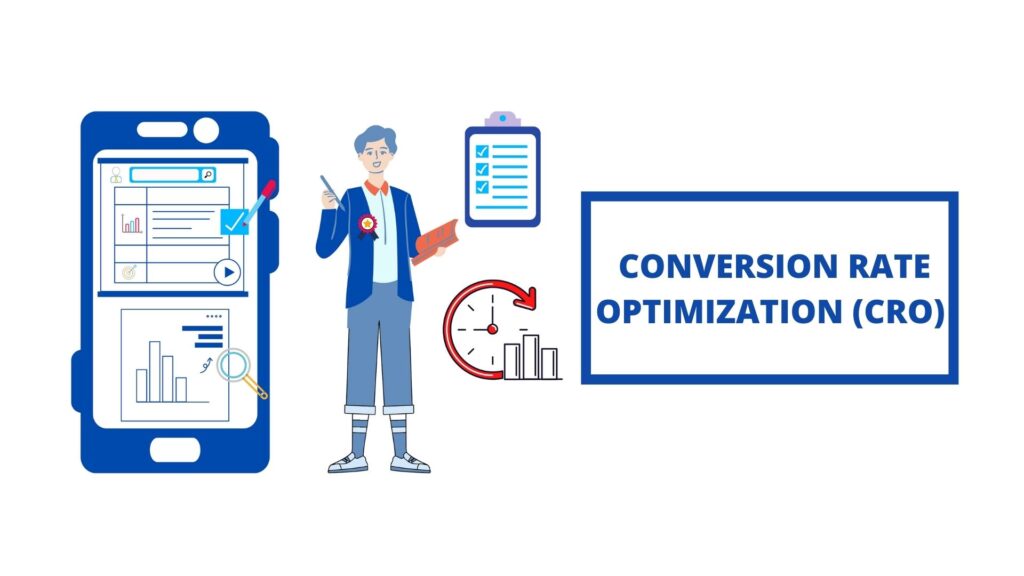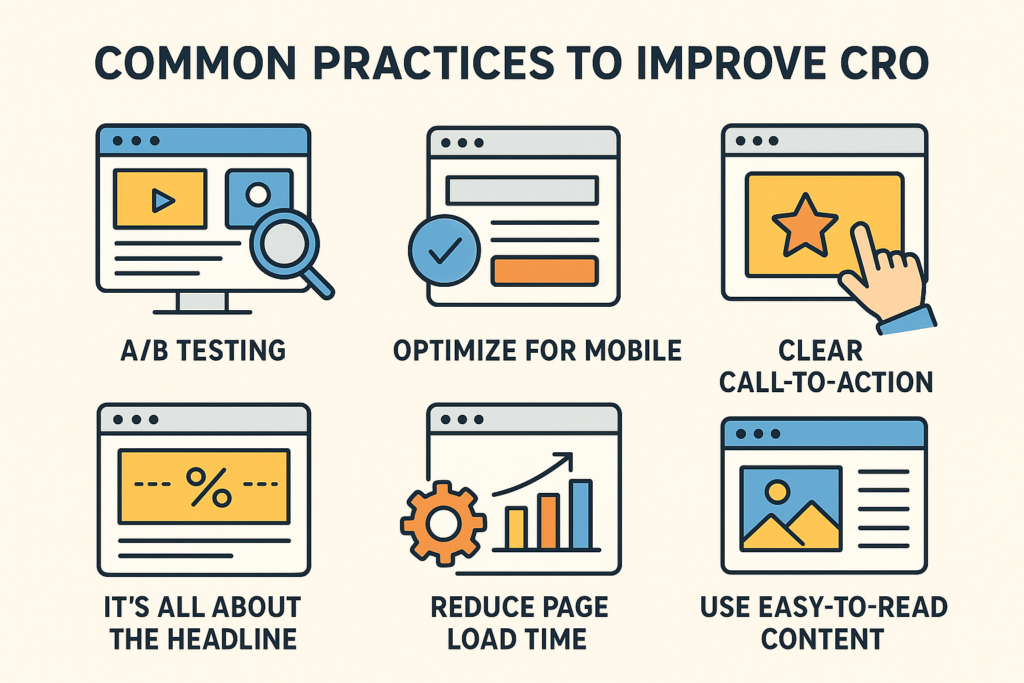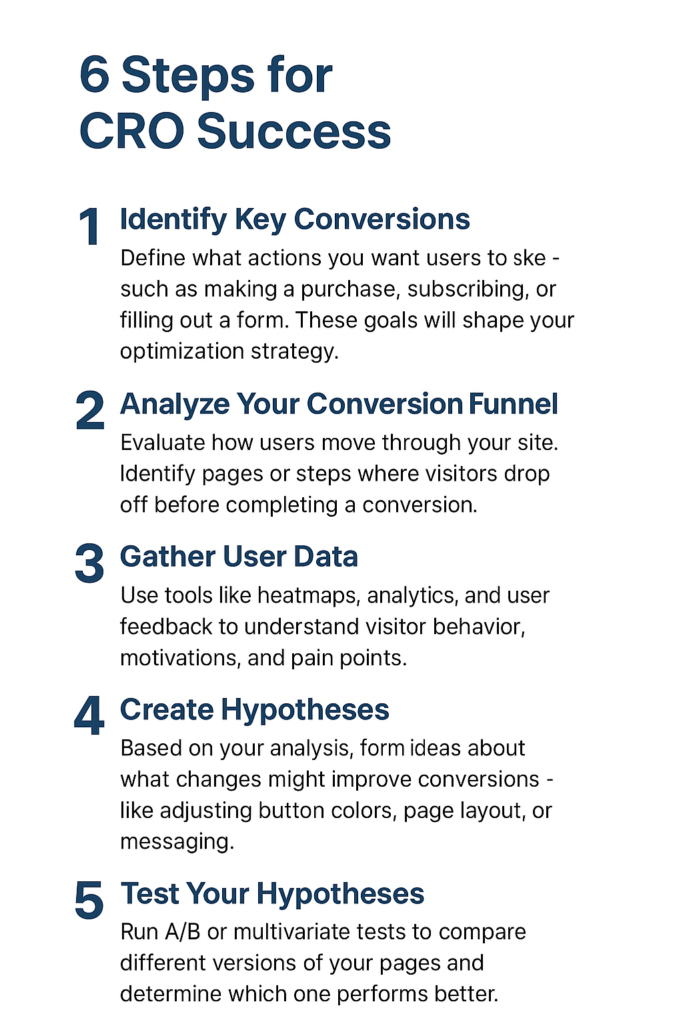
Do you want your website to attract more visitors and turn them into loyal customers? Conversion Rate Optimisation (CRO) is the key. By analyzing user behavior and website performance, CRO helps you maximize engagement, improve conversions, and understand your audience better.
In this guide, we’ll explore CRO basics, tools, practices, and actionable strategies to help your site outperform competitors.
Key Takeaways:
- CRO (Conversion Rate Optimisation) helps convert website visitors into active customers.
- Focus on improving user experience and understanding visitor behavior to drive conversions.
- Use A/B testing, heatmaps, and analytics to identify what works best.
- Implement clear CTAs, testimonials, and simple forms to increase engagement.
- Continuously test, analyze, and refine your website for better long-term results.
- Combining CRO and SEO creates a powerful strategy to attract and convert more users.
What Is Conversion Rate Optimisation (CRO)?
Conversion Rate Optimisation is the process of increasing the percentage of users who take a desired action on your website. These actions can include:
-
Purchasing products or services
-
Signing up for newsletters
-
Filling forms or surveys
-
Clicking on a call-to-action (CTA) button
Simply put, CRO helps you convert website visitors into active users or customers by understanding and optimizing their behavior.
How to Calculate Conversion Rate
Calculating your website’s conversion rate is simple:

Average conversion rates typically range between 1–4%, but your results may vary depending on audience type, industry, and goals.
Also Visit: Learn More About User Experience Design
Common Practices to Improve CRO

While every website is different, some widely used strategies to boost conversion rates include:
- Use Testimonials and Reviews – Builds trust and credibility.
- Highlight CTA Buttons with Contrast Colors – Makes actions clear and noticeable.
- Minimize Form Fields – Short forms improve submission rates.
- Offer Time-Limited Promotions – Creates urgency and increases conversions.
Remember: CRO strategies may vary in effectiveness depending on your audience. Always test and adjust.
Understanding Your Target Audience
To boost conversion rates effectively:
-
Analyze User Behavior: Track clicks, scrolls, and engagement patterns.
-
Gather Feedback: Collect insights from website visitors, designers, and sales/support teams.
-
Implement Iterative Changes: Gradual improvements lead to long-term success.
How to Increase Conversion Rate on Your Own
You don’t always need paid tools. Many improvements can be made by carefully analyzing user behavior and feedback:
- Track User Activity: Track how visitors interact with your site and identify patterns.
- Collect Feedback: Ask for opinions from users, team members, or staff responsible for sales and support.
- Combine Insights: Merge observations with tool-based data for actionable results.
A slow, consistent approach often delivers the best long-term results.
Must Read: Boost Conversion Rates for Healthcare Websites
Top Tools for Conversion Rate Optimisation
There are three different categories of CRO tools, which can help you to make conversion rate optimization a fruitful process :
1. Quantitative Tools
These tools are helpful in the collection of numerical data related to your website. Here are some of these tools:
- General Analytics tools – for tracking traffic on the website
- Website heat map tools – for calculating number or clicks and scrolls on the website
- Form analysis tools – for tracking various kinds of form submissions
- Funnel tools – for finding out the level of visitors in the sales funnel
- Customer Satisfaction tools – for measuring the scales of satisfaction level from 1 to 10
2. Qualitative Tools
For collecting non-numerical data based on the behaviour of users on a website, these tools are used. Following are those:
- Website feedback tools – for recording the feedback of users based on the questions asked on their experience
- Website recording tools – for showing the pattern of usage of the website by a particular person
- Usability testing tools – for the display of recorded thoughts or opinions of a few current users
- Online reviews – for checking out the experience of people of using your website/product
3. Testing Tools
These tools can be used for enhancing the conversion rate based on the results obtained by using both quantitative and qualitative tools. These are as follows:
- A/B testing tools – for testing out different variations or samples of a page and selecting the best one out of them
- Website session recording tools – for comparing different variants of a page and measuring customer behaviour on it
- Conversion tracking analytics tools – for keeping a track of ongoing conversions
- Website feedback tools – for keeping a record of ‘before and after’ of responses on your website.
Must Read: Best Conversion Rate Optimization (CRO) Tools
6 Steps for CRO Success

Step 1: Identify Key Conversions
Define what actions you want users to take, such as making a purchase, subscribing, or filling out a form. These goals will shape your optimisation strategy.
Step 2: Analyse Your Conversion Funnel
Evaluate how users move through your site. Identify pages or steps where visitors drop off before completing a conversion.
Step 3: Gather User Data
Use tools like heatmaps, analytics, and user feedback to understand visitor behavior, motivations, and pain points.
Step 4: Create Hypotheses
Based on your analysis, form ideas about what changes might improve conversions like adjusting button colors, page layout, or messaging.
Step 5: Test Your Hypotheses
Run A/B or multivariate tests to compare different versions of your pages and determine which one performs better.
Step 6: Review and Iterate
Analyze results, implement successful changes, and continue refining your website. CRO is an ongoing process that grows stronger with consistent testing.
FAQS About CRO:
What is Conversion Rate Optimisation?
Conversion Rate Optimisation (CRO) is the process of improving a website to increase the number of visitors who take desired actions like purchases, sign-ups, or downloads.
How to Optimise Conversion Rates?
You can optimise conversion rates by using A/B testing, improving user experience, simplifying navigation and forms, and using persuasive CTAs that guide users to act.
What is an Example of Conversion Optimization?
An example is changing a “Buy Now” button’s color or placement to see which version gets more clicks, or simplifying the checkout process to boost sales.
What is CRO and SEO?
CRO improves how well your site converts visitors, while SEO brings traffic from search engines. Together, they help attract and convert more potential customers.
Read Our More Blogs:

